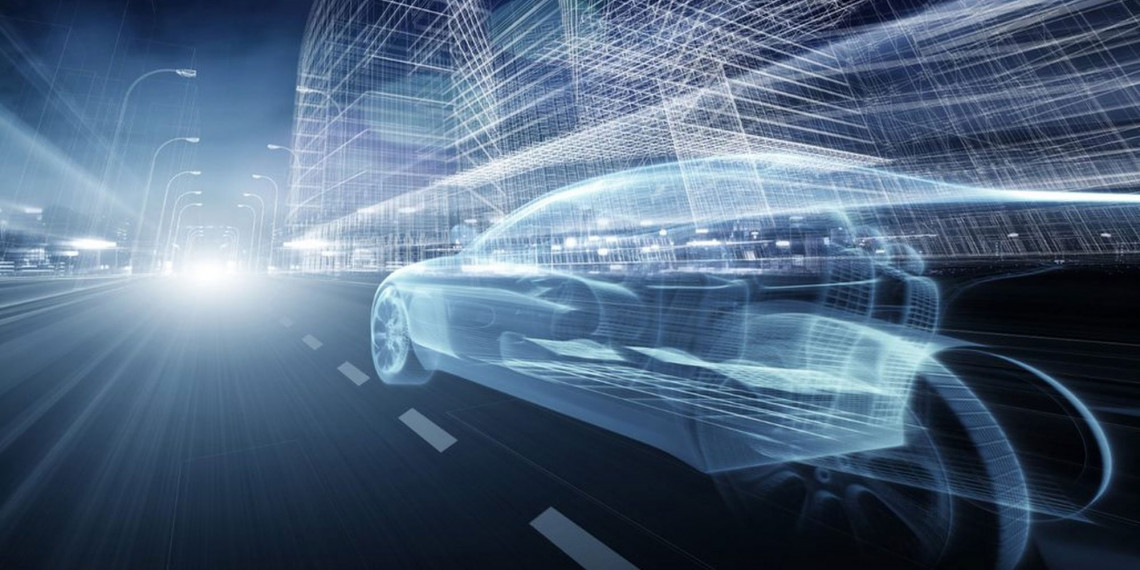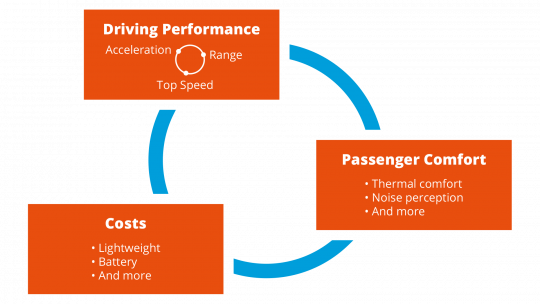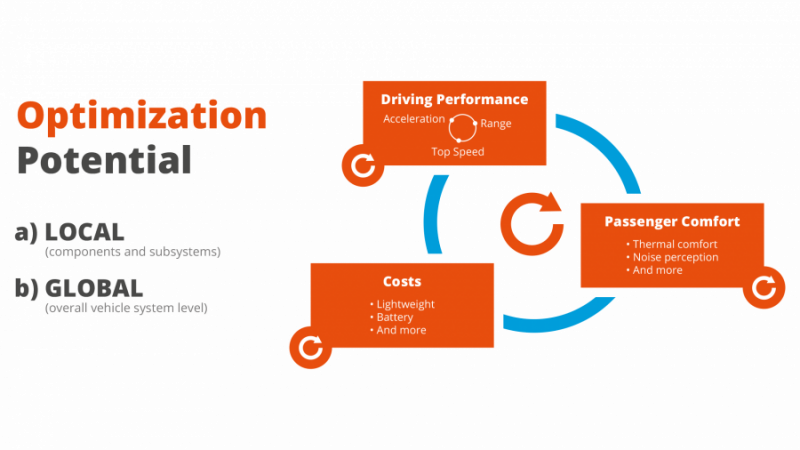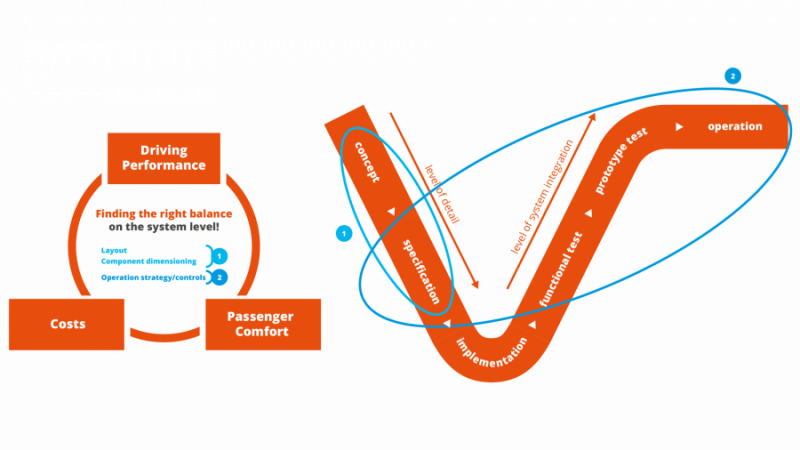Optimizing Electric Vehicle Performance and Defining Its Character
Exposing the main challenges of developing competitive EVs and how you can increase your vehicle’s performance, reliably define its character, while accelerating the development process.

More often than not, "keep it simple" is sound advice for good design and well-engineered products. But the reality is, technical progress often goes hand in hand with increased complexity, particularly in terms of improved energy efficiency and environmental friendliness. Even if a product looks simple from the outside and is intuitive to use (e.g. the Apple iPhone), it’s the behind-the-scenes complex technology that provides us with the experience and performance.
Let’s shift our focus to the development of electric vehicles. In order to meet market expectations, be environmentally friendly, and economical to produce & maintain, there must be a balance and understanding of not only complex technologies but conflicting objectives as well. Over the decades, many methods and tools have been introduced and refined to produce and develop vehicles on an industrial scale. However, changing product technology and complexity, as well as the need for quick adaptation to strict and continuously evolving environmental and safety standards, led to the necessity of new methods and tools. At the same time, the evolution of computer technology is opening the door for new options.
Main Challenges in Developing Competitive Electric Vehicles
1. Driving Performance: This group combines all characteristics directly related to the movement of the vehicle (e.g. acceleration, maximum speed, range). Upon closer examination, there are also conflicting objectives within these criteria themselves, for example, high acceleration and top speed usually result in a decreased range.
2. Passenger Comfort: Temperature control (heating and cooling) consumes a considerable amount of energy, which, again, results in decreased range. Additionally, the desire for a quiet driving experience, especially for the premium segment, could lead to reduced maximum range as noise encapsulation measures add weight and are a significant cost factor.
3. Cost: High-performance materials like aluminum alloys and composites can reduce a vehicle’s weight considerably – but they don’t come without a cost. Assuming that the range of an electric vehicle is inversely proportional to its weight, an increase in range, through high-tech materials, is associated with significantly higher vehicle costs. A similar correlation can be found with the battery. A battery with a higher energy capacity and energy density is usually considerably more expensive than one with lower capacity and energy density. In the luxury and supersport vehicle segments, the cost might not be a decisive limiting factor, but it certainly is for the cost-sensitive mass segment.
So, what does all this information tell us? Increasing driving performance and passenger comfort, while simultaneously reducing costs are, in most cases, conflicting objectives. But this doesn’t mean that optimization is out of the question for this triangle.
Potential for Optimizing the Properties of an Electric Vehicle
Looking at our circle of influencing factors again, there are generally two approaches to optimizing the characteristics of a vehicle and influencing its character: Local and global optimization. In this context, local describes the components and subsystems level, whereas global has its focus on the full vehicle perspective, integrating all components and functional systems.
To better understand the different potential for optimization, let’s take a deeper look at ‘Local’ and ‘Global’ optimization potential by referring to our three groups: Driving Performance, Passenger Comfort, and Costs.
Local optimization potential for EV development
Typically, increased acceleration and speed negatively impact range. However, by increasing a powertrain’s efficiency, we can simultaneously achieve higher acceleration, top speed, and greater range compared to the previous generation of vehicles. Modern simulation methods and computing power play an important role in achieving this goal.
Driving performance with a focus on the powertrain | High-fidelity finite element analysis, for example, is a major contributor to improving the geometry of powertrain components, thus reducing the weight of moving masses and friction losses. It also allows for new production methods and materials to be virtually tested in a very efficient manner. System simulation, on the other hand, is a proven method for investigating how all parts and components interact with each other so that we can understand the dependencies (e.g. vibrations, thermal influences, energy conversion e.g. from electrical to mechanical) and optimize their interaction. All these methods, stand-alone or combined, significantly contribute to improving a powertrain’s efficiency.
Passenger comfort | In combustion engine vehicles, heat is a waste product of the engine. In an electric vehicle, the heating system consumes its share of the limited energy stored in the battery. The best way to get the most range out of your electric vehicle is to switch off the HVAC system. Naturally, we want both: thermal comfort and range. One way to achieve this is by reducing energy losses when generating and moving cool and hot air. Another option is optimizing the temperature distribution within the cabin. This way, the thermal comfort zone is concentrated close to the occupant(s) and avoids cooling or heating empty space.
For acoustic comfort, there is potential for smart improvement. Understanding noise transmission paths, closing transmission cavities, and minimizing noise sources offers significant potential for design improvement that goes beyond simply adding mass in the form of an insulating material when optimizing powertrain noise, tire/road interaction, wind noise, etc. Dedicated acoustic simulation is a highly efficient method for evaluations like these, which can be combined with vibration simulations coming from the source (e.g. gears).
Costs | Lightweight products using high-performance materials tend to be expensive. But a clever design and optimized geometry make lightweight solutions a reality – for a reasonable cost. It comes down to making smart decisions about where expensive materials have the greatest effect. One instance is using high-strength steel, in the B-pillar for example, to ensure structural integrity at critical points or the clever use of composites. Utilizing a mix of materials is an effective way to achieve high performance – such as high acceleration and range – through lightweight design. Finite Element Analysis (FEM) gives reliable information of where high-performance material contributes best to lightweight targets while ensuring optimal crash safety.
Global optimization potential for EV development
While the focus at the local level is mainly on technological optimization within a subsystem or component, the overall character and performance of the vehicle is defined by the global interaction of all components and subsystems as one integrated unit. In this context, the principal architecture (e.g. one central motor, four-wheel hub motors, or any combination of both), the balance between the dimensions of the individual components, and, the controls of the overall system (e.g. driving mode control, energy management, etc.) are significant influencers.
All these factors must be considered to find the right balance in terms of overall performance and the vehicle character defined by segment and brand. For electric vehicles, finding an optimal balance between competing targets is essential for developing competitive products throughout almost all sections of the V-Cycle and during operation.
In the concept and specification phase, which happens at the beginning of the development process, the vehicle’s architecture must be defined and so must the dimensions of the individual components. After defining and developing the components and subsystems (at least virtually), testing their function in the context of the overall vehicle is the next step. When talking about the complete vehicle, operation strategies and control systems have a significant influence on the interaction of all components and subsystems and thus on vehicle performance and character – both can even be changed during operation (e.g. through software updates or by selecting different vehicle modes such as eco or sport).
To optimize the complex interactions of all components, subsystems, and controls in all phases of the development process and during operation, system simulation is a proven method.
Combine Local and Global optimization for full control over your vehicle's performance and character
After reviewing both local and global optimizations, it becomes clear that numerous components, and thus development departments, are involved in optimizing performance and defining a vehicle’s character. For the best results, all perspectives (local and global) should be considered and balanced. Using the right simulation solution for each task helps increase your vehicle’s performance, reliably define its character, and, at the same time, accelerate the development process.
Learn from Virtual Prototyping experts
You want to learn more about how to test & design electric vehicles in a sustainable, virtual way that equally allows you to efficiently develop the best strategy for optimal range while reducing the amount of test needed? Watch our webinar "Developing Electric Vehicles That Go the Distance" on-demand.
Last update: September 21, 2023
Thomas Hofmann is a Senior Industry Marketer at ESI. He studied at the Dresden University of Technology in Germany and at the University of Botswana and graduated in 2012 as Dipl.-Ing. (equivalent to a master’s degree) in Mechanical Engineering. Thomas joined ITI GmbH – now part of the ESI group – in 2013 as Technical Marketing Engineer and held several positions in product marketing and business development. His primary focus is to understand market requirements and match them with ESI's unique capabilities to enable customers to achieve their desired goals.


